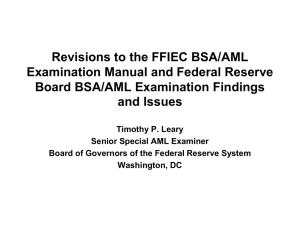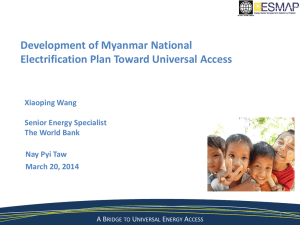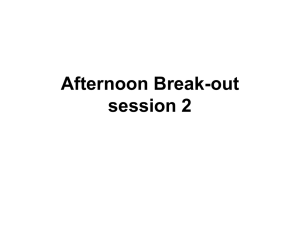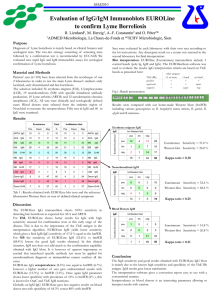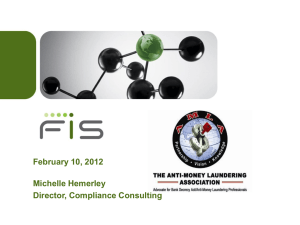Podocyte and food antigens in membranous nephropathy (PPT
advertisement
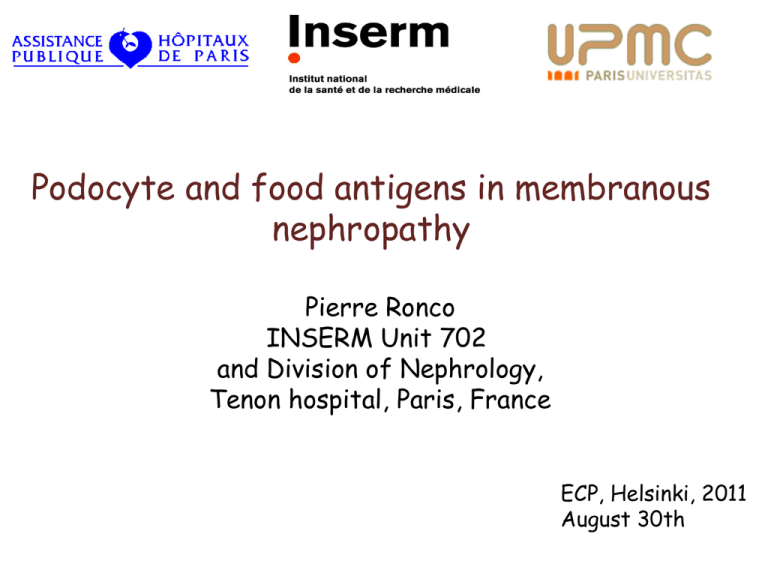
Podocyte and food antigens in membranous nephropathy Pierre Ronco INSERM Unit 702 and Division of Nephrology, Tenon hospital, Paris, France ECP, Helsinki, 2011 August 30th Membranous Nephropathy Major cause of nephrotic syndrome and chronic renal failure Aetiologies of membranous nephropathy • 30% associated with : - infections - cancers - autoimmune diseases - drugs • 70% « idiopathic forms » • Proteinuria is complement-dependent, and may involve production of oxygen free radicals and metalloproteases Membranous Nephropathy: IgG Subclass Distribution IgG1 IgG2 IgG3 IgG4 Idiopathic + + ± ++++ Lupus +++ +++ ++ ± Neoplasia +++ +++ + + Ohtani et al, Nephrol Dial Transplant, 2004, 19:574 Possible mechanisms of the formation of subepithelial deposits Serum Sickness Heymann nephritis « Planted » antigen Glassock , New Engl J Med 2009, 361:81 Heymann nephritis Renal BB IgG deposits Megalin, the target antigen of HN Podocytes Activation of complement Rat: megalin Human? GBM Proteinuria Endothelium In situ formation of immune deposits Kerjaschki and Farquhar From rats to men : Allo-immune neonatal MN 1982-2002 The case : Hugo D. (male gender) • 34 Wks of gestation : oligohydramnios and enlarged kidneys • 38 Wks : birth • 1st Days of life : respiratory distress and oligoanuria, followed by nephrotic range proteinuria and increased blood pressure • 4 Wks : CT-guided kidney biopsy • Negative tests for syphilis, toxoplasmosis, cytomegalovirus and hepatitis -B virus infections • Negative Coombs’ test. Normal levels of complement components at day 35 PLACENTA MOTHER before FETUS after NEP NEP NEP mother 1 2 control 1 NEP 2 175 IgG C5b-9 83 Blot: anti-NEP mAb anti-NEP IgG Infant born with MN and nephrotic syndrome Debiec et al. N Engl J Med 2002, 346:2053 Potential mechanisms of albuminuria Green IgG green Red NEP - IgG red C5b-9- NEP Blue Induction of neonatal renal disease in pregnant rabbit by injection of human maternal IgG NEWBORN RABBIT KIDNEY Human IgG NEP Why did the mother become immunized without developing the renal disease ? PLACENTA MOTHER FETUS Genetic defect Podocytes NEP NEP deficient M C NEP GBM Y NEP Y Endothelium IgG C5b-9 anti-NEP IgG IgG (Debiec et al. Lancet. 2004) Infant born with MN and nephrotic syndrome Feto-Maternal Allo-Immunization with antenatal Glomerulopathies (FMAIG) Western blotting of glomerular proteins with serum from patients with iMN Beck et al, New Engl J Med, 2009, 361:11 Expression of PLA2R in normal kidney and glomeruli Beck et al, New Engl J Med, 2009, 361:11 GWAS analysis of patients with idiopathic MN • Three cohorts Patients Controls French 75 157 Dutch 146 1,832 British 335 349 Total 556 2,338 • Controls : ethnically matched • Illumina platform : 300,000 SNPs • Bioinformatics analysis Stanescu et al, New Engl J Med, 2011, 364: 616 Single Nucleotide Polymorphisms (SNPs) • • • • • • • Single base mutation in DNA Most simple form of genetic polymorphism 90% of all human DNA polymorphisms Occur 0.5-10 per every 1 000 base pairs Not uniformly distributed > 1, 000, 000 SNPs identified SNP in a coding region can be – Synonymous (silent mutation) – Non-synonymous (missense or nonsense mutation) Principle of pangenomic (GWAS) studies A risk HLA-DQA1 allele is associated with iMN and may interact with PLA2R alleles French (n=75 ; c=157) British (n=335 ; c=349) Dutch (n=146 ; c=1832) All patients (n=556; c=2338) Stanescu et al, New Engl J Med, 2011, 364: 616 Conclusions • An HLA-DQA1 allele on chromosome 6p21 is most closely associated with idiopathic membranous nephropathy in persons of white ancestry • This allele may facilitate an autoimmune response against targets such as variants of PLA2R1 • Our findings suggest a basis for understanding this disease and illuminate how adaptive immunity is regulated by HLA • The risk of iMN is higher with the HLA-DQA1 allele than with the PLA2R1 allele, suggesting that the HLA-DQ1 allele might favor autoantibody targeting also other antigens PLA2R autoantibodies and PLA2R glomerular deposits in membranous nephropathy Debiec and Ronco, New Engl J Med, 2011, 364 :689 Are there other antigens on the horizon in patients with idiopathic MN ? Screening of MN sera reactivity with podocyte « proteome » Human podocyte lysates kDa 110 80 Western blot analysis 47 32 24 1 2 3 4 5 6 7 8 9 Patients’ sera Different autoantibody profiles Identification of antigens Human podocyte lysate Differential extraction Ion exchange chromatography MALDI-TOF MS 2D-electrophoresis Identification MALDI-TOF MS LC-MS/MS Western immunoblotting with patient’s serum Silver staining Candidate autoantigens recognized by autoantibodies in sera from MN patients > 10 Cytoplasm/cytoskeletal proteins « Metabolic » proteins Molecular chaperones Cytoskeletal proteins J Am Soc Nephrol 21 : 507-519, 2010 Mechanisms of immune complex formation and podocyte injury in MN Initiation Progression Proteinuria Podocytes Cytoskeletal changes DNA damage GBM Activation of complement ROS Proteases C5b-9 NEP Progression PLA2R Altered intracellular transport Apoptosis Lack of proliferation C5b-9 degradation Endothelium Podocytopenia Detachment Renal failure SOD2 Aldose reductase Enolase (Wakui et al, 1999) Stress proteins Cytoskeletal proteins A role for nonnative antigens? Serum Sickness Heymann nephritis « Planted » antigen Glassock , New Engl J Med 2009, 361:81 Anti-BSA antibodies in patients with MN Debiec et al, NEJM 2011, 364 : 2101 IgG binding of BSA synthetic peptides M MN patients NA M 1.4 1.2 1.4 1.2 0.8 0.8 OD 1 OD 1 Controls B 0.6 0.6 0.4 0.4 0.2 0.2 0 0 0 1 2 3 4 5 6 7 8 9 Peptide 10 11 12 13 14 0 Peptide CDEFKADEKKFWGKYLY HSA CTAFHDNEETFLKKYLY Debiec et al, NEJM 2011, 364 : 2101 2 3 4 5 6 7 8 Peptide 9 10 11 Peptide BSA BSA 1 HSA 12 13 14 Circulating BSA in patients with MN B ELISA BSA 2D electrophoresis and immunoblot Debiec et al, NEJM 2011, 364 : 2101 Colocalization of BSA and IgG in immune deposits BSA IgG Green BSA Red IgG Biopsy specimen stained for IgG subclasses Reactivity of eluted IgG Patient with BSA in biopsy IgG1 IgG2 1 4 1 4 BSA IgG3 IgG4 HSA Patients without BSA in biopsy 1 4 1 4 1 4 1 4 BSA Debiec et al, NEJM 2011, 364 : 2101 Role of BSA in the pathophysiology of MN BSA Processing Digestion APC T cell B cell YYY Absorption of antigen from the intestinal tract Anti-BSA Antibodies Proteinuria g/l Association with disease activity 10 IgG subclass 1 5 2004 2004 2005 2006 Circulating BSA ng/ml 1000 500 2004 2006 2008 2008 2 3 4 initial disease 2006 relapse 2008 remission What do these results teach us? • The repertoire of antigens involved in « idiopathic » MN may include nonglomerular antigens • Food cationized BSA and/or abnormal processing of BSA in the GI tract in young children may lead to passage in the blood of cationic BSA, immunization, and in situ formation of immune complexes (Border et al, J Clin Invest, 1982, 69:451) • These cases point to a role for environmental factors in the pathogenesis of MN The spectrum of human membranous nephropathies • Neonatal, alloimmune : NEP • Early childhood MN : BSA • « Idiopathic » MN - 70-80% : PLA2R (+ other specificities:AR, SOD2, enolase..?) - 20-30% : other Ags including food/environmental Ag (BSA) • « Secondary » MN Ags to be identified • Graft MN - Recurrent : PLA2R (and other antigens) - de novo : allo-immune Acknowledgments Bergamo (I) G. Remuzzi M. Abbate Nijmegen (NL) J. Wetzels J. Hofstra UK R. Kleta (London) P. Mathieson (Bristol) A.Rees (Vienna) CNG (Evry) D. Bacq-Daian Paediatricians V. Guigonis (Limoges, F) A. Bensman (Paris, F) G. Deschênes (Paris, F) T. Ulinski (Paris, F) J. Nauta (Rotterdam, NL) F. Janssen (Brussels, B) J. Nortier (Brussels, B) D. Bockenhauer (London, UK) M. Kemper (Hamburg, D) B. Stengel (Paris, F) Anti-PLA2R antibody in membranous nephropathy Positive for anti-PLA2R (%) Europe + Asia 100 N=466 64.5% N=45 N=14 N=18 N=13 4.4% 28% 17% 15% N=90 N=153 0% 0% 75 50 25 iMN LN-MN Cancer HBV GvH Secondary MN DC HC Debiec ,Tesar and Ronco; Hoxha et al, NDT 2011; Qin et al, JASN 2011 Positive for anti-PLA2R (%) Anti-PLA2R antibody in idiopathic membranous nephropathy 100 N=25 68% N=142 65% N=42 57% N=100 52% N=81 72% N=16 43% N=60 80% iMN Japan iMN China 75 50 25 iMN iMN Italy Dutch iMN iMN iMN France Germany Czech IFA Debiec ,Tesar and Ronco; Hoxha et al, NDT 2011; Qin et al, JASN 2011

